Techno-Economic Feasibility of Off-Grid Renewable Energy Electrification Schemes: A Case Study of an Informal Settlement in Namibia
Abstract
:1. Introduction
1.1. Potential Renewable Resources in Namibia
- Namibia receives abundant solar radiation, with daily global horizontal irradiation between 4.4 kWh/m2 along the coastal areas and roughly 7.8 kWh/m2 in arid areas. A pre-feasibility study established that more than 33,000 km2 of potential sites for concentrated solar power exist in the country and produce up to 250 GWe [40,41].
- Average wind speed in the country ranges from 4 to 15 m/s, with higher speed expected along the coastline. A wind-power density of class 7 can be expected on the Luderitz coastline and class 3 in most parts of the country [42].
- Encroacher bush and solid waste are key biomass resources in Namibia for electricity generation. There are approximately 260 billion m2 of bush-encroached land in the country and it is expected to grow by 3.2% annually [43].
- A natural gas field with the potential for an 800 MW (nominal) power plant was discovered in offshore Namibia, but its implementation remains elusive [44].
1.2. Overview of the Namibian Power Sector
1.3. Problem Identification and Study Objectives
1.4. Study Contributions
- It examines different off-grid energy configurations that can supply the load profile expected in a typical informal settlement or peri-urban community.
- It presents a comparative analysis of the deployment of individual solar home systems to each resident versus supplying electricity from a centralized microgrid.
- It implements a “framework for rural energy system design” proposed by Ali et al. [61] and assesses its performance for an informal settlement.
- It provides a holistic feasibility study that considers both technical, economic, social, and governance aspects in determining the optimal and practical energy solution for the selected community.
- It provides insight on whether an off-grid renewable energy system designed for an informal settlement will have techno-economic characteristics similar to a rural area, an urban area, or otherwise.
- It can inform power system planners, policy makers, energy investors, and other researchers on the technical and economic conditions to electrify a peri-urban area using renewable energy sources.
2. Related Techno-Economic Studies on Hybrid Renewable Energy Systems
| No | Year | Case Study | Load Type | Objective and Optimization Tool(s) | Key Findings |
|---|---|---|---|---|---|
| 1 | 2022 | Bangladesh [69] | Remote western coastal region |
|
|
| 2 | 2022 | Makkah Province, Saudi Arabia [70] | Remote commercial facility |
|
|
| 3 | 2021 | Dera Ismail Khan, Pakistan [61] | Semi-electrified village |
|
|
| 4 | 2021 | Upanga and Ngamiani, Tanzania [71] | Medical facilities |
|
|
| 5 | 2021 | Various Developing Countries [72] | Rural communities |
|
|
| 6 | 2020 | Benin, Africa [73] | Remote village |
|
|
| 7 | 2019 | Chungbuk Innovation City, South Korea [78] | Town |
|
|
| 8 | 2019 | Jiuduansha, Near Shanghai, China [75] | Remote island |
|
|
| 9 | 2019 | Maluku Province, Indonesia [79] | Remote villages |
|
|
| 10 | 2019 | Yamunanagar, India [74] | Rural community |
|
|
| 11 | 2018 | Godagari, Bangladesh [80] | Remote areas |
|
|
| 12 | 2018 | Mbeni, Comoros [81] | Remote island |
|
|
3. Materials and Methods
3.1. Site Socio-Economic Assessment
3.2. Load Assessment
- Determined the surface area of the unelectrified Havana settlement.
- Estimated the dwellings’ density per 100 m2 from the aerial and satellite imagery in Google Maps and then extrapolated to determine the total units in the area. A head count of about 3 dwellings per 100 m2 was observed.
- Estimated the ratio of residential (80%), commercial (10%), and public institutions such as schools and clinics (10%). The commercial dwellings are comprised of small grocery shops and liquor shops, home businesses, and other informal businesses.
- Divided the residential units into different classes and estimated expected the daily load. A class ratio of 65% Shack-12sqm, 25% Shack-24sqm, and 10% Brick-House were assumed. Each residential class was assumed to have the same number and types of appliances, which were operated at the same time window. The loads for commercial and public institutions were estimated as different scales of the Brick-House daily load. Details of the daily profile for Shack-24sqm are shown in Table 4, and the total load expected for the area in Table 5.
- Ideal relative load demand curves of domestic and commercial profiles common to developing countries were assumed. Single-day curves are shown in Figure 5 and Figure 6, respectively. Relative load demand at any hour , is a normalized load (per unit) defined as the ratio between average hourly demand and peak demand , over a period of time .
- To make the load profiles more realistic, the daily relative demand profiles were first scaled by average daily consumption (kWh/day) before randomness was added. A 20% day-to-day variance and 10% hourly time-step variance were assumed.
| Load Type | Power (W) | Qty | Total Power (W) | Total Daily Use (Hours) | Daily Demand (kWh/Day) |
|---|---|---|---|---|---|
| Living room light | 15 | 1 | 15 | 2 | 0.030 |
| Bedrooms lights | 15 | 2 | 30 | 2 | 0.060 |
| Security light | 15 | 1 | 15 | 10 | 0.150 |
| Single plate cooker | 1275 | 1 | 1275 | 0.7 | 0.893 |
| Fridge (150 lt = 5.3 Cu Ft) | 105 | 1 | 105 | 6 | 0.630 |
| Cell phone charging | 9 | 2 | 18 | 1 | 0.018 |
| Radio | 12 | 1 | 12 | 2 | 0.024 |
| Television (21″ LCD) | 150 | 1 | 150 | 6 | 0.900 |
| Average energy demand (kWh/day) | 2.705 | ||||
| Average power demand (kW/day) | 0.113 | ||||
| Peak demand (kW/day) | 0.436 | ||||
| Facility | Total Units | Unit Demand (kWh/Day) | Total Daily Demand (kWh/Day) | % Daily Demand |
|---|---|---|---|---|
| Shack-12 sqm | 8303 | 1.76 | 14,595.88 | 38.12% |
| Shack-24 sqm | 3193 | 2.70 | 8636.25 | 22.55% |
| Brick-House | 1277 | 7.54 | 9628.40 | 25.14% |
| Liquor shops * | 102 | 15.08 | 1540.54 | 4.02% |
| Mini grocery shops | 102 | 16.58 | 1694.60 | 4.43% |
| Small-scale industries | 102 | 20.73 | 2118.25 | 5.53% |
| Public services (e.g., schools, clinics, libraries) | 3 | 26.38 | 79.15 | 0.21% |
| Total average energy demand (kWh/day) | 38,293.07 | |||
| Average residential load (kWh/day) | 32,860.53 | |||
| Average community load (kWh/day) | 5432.54 | |||
| Total peak demand (kW/day) | 1595.54 | |||
3.3. Renewable Resource Assessment
3.4. System Component Capacities and Costs
3.4.1. Solar Photovoltaic Capacity
3.4.2. Wind Capacity
- Generate statistically reasonable hourly time series wind data from monthly average wind speeds. This step is only performed when time-series data are not available, as with the case in this study.
- Calculates the wind speed for the selected wind turbine’s hub height. A generic wind turbine of 3 kW rating and 50 m hub height is selected for the study.
- Uses the wind turbine power curve to predict the amount of output power that can be produced at the wind speed computed in step 2, and at standard air density.
- Adjusts the output power in step 3 for the actual air density as follows [60].where is the wind turbine output power in kW, is the actual air density in kg/m3, is the air density at standard conditions (1.225 kg/m3), and is the wind turbine output power in kW at standard.
3.4.3. Diesel Generator, Battery Storage, and Capacity
3.4.4. Component Costs
3.5. Techno-Economic Analysis
3.5.1. Net Present Cost
3.5.2. Levelized Cost of Energy
3.5.3. Discounted Payback Period
3.5.4. Other Economic Inputs
3.5.5. Potential Energy Configurations
3.5.6. Energy Dispatching
4. Results and Discussion
4.1. Electrification through Solar Home Systems (SHS)
4.2. Electrification through Microgrids
4.3. Comparing Electrical Productions
4.4. Sensitivity Analysis
4.4.1. Fuel Price Variations
4.4.2. Load Variations
4.4.3. PV Installed Costs Variations
4.5. Specific Implementation Considerations for the Selected Study Area
5. Conclusions and Recommendations
Author Contributions
Funding
Institutional Review Board Statement
Informed Consent Statement
Data Availability Statement
Acknowledgments
Conflicts of Interest
Abbreviations
| BAT | Battery |
| CC | Cycle Charging |
| CCGT | Combined Cycle Gas Turbine |
| DG | Diesel Generator |
| EV | Electric Vehicle |
| FC | Fuel Cell |
| GHI | Global Horizontal Irradiance |
| GWe | Giga Watt electric |
| HOMER | Hybrid Optimization of Multiple Energy Resources |
| HRES | Hybrid Renewable Energy Systems |
| IPP | Independent Power Producer |
| kW | Kilowatt |
| kWh | kilowatt-hour |
| L | Liter |
| LCD | Liquid Crystal Display |
| LCOE | Levelized Cost of Energy |
| LF | Load Following |
| MATLAB | Matrix Laboratory (software) |
| MPPT | Maximum Power Point Tracking |
| MSB | Modified Single Buyer |
| MW | Megawatt |
| MWh | Megawatt hour |
| NASA | National Aeronautics and Space Administration |
| NPC | Net Present Cost |
| O&M | Operation and Maintenance |
| PESTEL | Political/Policy, Economic, Social, Technological, Environmental, and Legal |
| PV | Photovoltaic |
| SAPP | Southern African Power Pool |
| SHS | Solar Home System |
| SRF | Solar Revolving Fund |
| SSA | Sub-Saharan Africa |
| WT | Wind Turbine |
References
- William, R. Goal 7. Ensure Access to Affordable, Reliable, Sustainable, and Modern Energy for All, in A New Era in Global Health-Nursing and the United Nations 2030 Agenda for Sustainable Development; Springer: Berlin/Heidelberg, Germany, 2018. [Google Scholar] [CrossRef]
- Bos, K.; Chaplin, D.; Mamun, A. Benefits and challenges of expanding grid electricity in Africa: A review of rigorous evidence on household impacts in developing countries. Energy Sustain. Dev. 2018, 44, 64–77. [Google Scholar] [CrossRef]
- IEA; IRENA; The World Bank; World Health Organization. Tracking SDG 7: The Energy Progress Report 2020; IEA: Paris, France, 2020. [Google Scholar]
- Brew-Hammond, A. Energy access in Africa: Challenges ahead. Energy Policy 2010, 38, 2291–2301. [Google Scholar] [CrossRef]
- IRENA. Energy Profile—Namibia. 2021. Available online: https://www.irena.org/IRENADocuments/Statistical_Profiles/Africa/Namibia_Africa_RE_SP.pdf (accessed on 27 February 2022).
- The World Bank. Access to Electricity (% of Population)—Namibia. 2022. Available online: https://data.worldbank.org/indicator/EG.ELC.ACCS.ZS?locations=NA (accessed on 27 February 2022).
- Tenenbaum, B.; Greacen, C.; Siyambalapitiya, T.; Knucles, J. From the Bottom Up: How Small Power Producers and Mini-Grids Can Deliver Electrification and Renewable Energy in Africa; World Ban Publications: Washington, DC, USA, 2014; pp. 1–30. [Google Scholar]
- Lennon, J. How Namibia’s Housing Shortage Became a Humanitarian Crisis. 2018. Available online: https://jade-lennon.medium.com/how-namibias-housing-shortage-became-a-humanitarian-crisis-eef05ba14b9b (accessed on 27 February 2022).
- Endjala, T.; Botes, L. Surviving like a Bird: Livelihood Coping Strategies in an Informal Settlement of Windhoek, Namibia. Afr. Sociol. 2020, 24, 151–173. [Google Scholar]
- Weber, B.; Mendelsohn, J. Informal Settlements in Namibia: Their Nature and Growth; Development Workshop Namibia: Windhoek, Namibia, 2017; Available online: https://www.raison.com.na/sites/default/files/Informal-Settlements-in-Namibia-Book-Web.pdf (accessed on 2 March 2022).
- Republic of South Africa. Informal Settlements Policy Guidelines for Integrated National Electrification Programme (INEP); Department of Energy: Pretoria, South Africa, 2018. Available online: http://www.energy.gov.za/files/policies/electrification/Informal-Settlements-Policy-Guidelines-for-INEP.pdf (accessed on 2 March 2022).
- Republic of Namibia. Response to the Questionnaire of Informal Settlements in Namibia and Human Rights; Ministry of Justice: Windhoek, Namibia, 2017. Available online: https://www.ohchr.org/sites/default/files/Documents/Issues/Housing/InformalSettlements/Namibia.pdf (accessed on 2 March 2022).
- Singh, M.; Balachandra, P. Microhybrid Electricity System for Energy Access, Livelihoods, and Empowerment. Proc. IEEE 2019, 107, 1995–2007. [Google Scholar] [CrossRef]
- Opiyo, N.N. How solar home systems temporally stimulate increasing power demands in rural households of Sub-Saharan Africa. Energy Trans. 2020, 4, 141–153. [Google Scholar] [CrossRef]
- Pelz, S.; Pachauri, S.; Groh, S. A critical review of modern approaches for multidimensional energy poverty measurement. Wiley Interdiscip. Rev. Energy Environ. 2018, 7, e304. [Google Scholar] [CrossRef] [Green Version]
- IRENA. Fostering Livelihoods with Decentralised Renewable Energy: An Ecosystem Approach. 2022. Available online: https://www.irena.org/-/media/Files/IRENA/Agency/Publication/2022/Jan/IRENA_Livelihood_Decentralised_Renewables_2022.pdf (accessed on 2 March 2022).
- Hussein, M.A. Analysis of energy as a precondition for improvement of living conditions and poverty reduction in sub-Saharan Africa. Sci. Res. Essays 2012, 7, 2656–2666. [Google Scholar] [CrossRef]
- Markandya, A.; Wilkinson, P. Electricity generation and health. Lancet 2007, 370, 979–990. [Google Scholar] [CrossRef]
- Sverdlik, A. Ill-health and poverty: A literature review on health in informal settlements. Environ. Urban. 2011, 23, 979–990. [Google Scholar] [CrossRef]
- Ortega, N.; Curto, A.; Dimitrova, A.; Nunes, J.; Rasella, D.; Sacoor, C.; Tonne, C. Health and environmental impacts of replacing kerosene-based lighting with renewable electricity in East Africa. Energy Sustain. Dev. 2021, 63, 16–23. [Google Scholar] [CrossRef]
- Republic of Namibia. National Electrification Policy; Ministry of Mines and Energy: Windhoek, Namibia, 2020. Available online: https://www.ecb.org.na/images/docs/Economic_Regulation/1st%20DRAFT%20-%20National%20Electrification%20Policy%20-%20Rev%202%20-%2020200916.pdf (accessed on 2 March 2022).
- Jain, P.K.; Jain, P.; Dhafana, P. Addressing Barriers to Off-Grid Rural Electrification in Africa: The Botswana and Namibia Experience. 2014. Available online: https://www.researchgate.net/publication/281612732 (accessed on 2 March 2022).
- Hoeck, I.; Steurer, E.; Dolunay, Ö.; Ileka, H. Challenges for off-grid electrification in rural areas. Assessment of the situation in Namibia using the examples of Gam and Tsumkwe. Energy Ecol. Environ. 2021. [Google Scholar] [CrossRef]
- Namibia Power Corporation. Nampower Annual Report 2021; Nampower: Windhoek, Namibia, 2021; Available online: https://www.nampower.com.na/public/docs/annual-reports/NamPower/Annual/Report/202021.pdf (accessed on 6 May 2022).
- von Oertzen, D. State of the Namibian Electricity Sector, Windhoek; Konrad-Adenauer-Stiftung: Bonn, Germany, 2019. [Google Scholar]
- Akpeji, K.O.; Olasoji, A.O.; Gaunt, C.; Oyedokun, D.T.O.; Awodele, K.O.; Folly, K.A. Economic impact of electricity supply interruptions in south Africa. SAIEE Afr. Res. J. 2020, 111, 73–87. [Google Scholar] [CrossRef]
- NREL. Documenting a Decade of Cost Declines for PV Systems. 2021. Available online: https://www.nrel.gov/news/program/2021/documenting-a-decade-of-cost-declines-for-pv-systems.html (accessed on 27 February 2022).
- Hansen, K. Decision-making based on energy costs: Comparing levelized cost of energy and energy system costs. Energy Strategy Rev. 2019, 24, 68–82. [Google Scholar] [CrossRef]
- IRENA. World Energy Transitions Outlook 2022: 1.5 °C Pathway. 2022. Available online: https://www.irena.org/-/media/Files/IRENA/Agency/Publication/2022/Mar/IRENA_World_Energy_Transitions_Outlook_2022.pdf (accessed on 10 May 2022).
- Lou, X.; Li, L.M.W.; Xia, W.; Zhu, Q. A meta-analysis of temporal shifts in environmental concern between 1994 and 2017: An examination of the new environmental paradigm. Anthropocene 2022, 38, 100335. [Google Scholar] [CrossRef]
- Solar Plaza, Top 5 Fastest-Growing Solar Markets in Africa. 2019. Available online: https://www.qualenergia.it/wp-content/uploads/2019/09/White-Paper-The-Big-5-Africa-fastest-growing-solar-energy-markets.pdf (accessed on 27 February 2022).
- IRENA. Global Renewables Outlook: Energy Transformation 2050. 2020. Available online: https://www.irena.org/publications/2020/Apr/Global-Renewables-Outlook-2020 (accessed on 10 May 2022).
- IRENA. Renewable Power Generation Costs 2020. 2020. Available online: https://www.irena.org/-/media/Files/IRENA/Agency/Publication/2021/Jun/IRENA_Power_Generation_Costs_2020.pdf (accessed on 2 March 2022).
- Feldman, D.; Ramasamy, V.; Fu, R.; Ramdas, A.; Desai, J.; Margolis, R.U.S. Solar Photovoltaic System and Energy Storage Cost Benchmark: Q1 2020. 2020. Available online: https://www.nrel.gov/docs/fy21osti/77324.pdf (accessed on 2 March 2022).
- Fu, R.; James, T.L.; Chung, D.; Gagne, D.; Lopez, A.; Dobos, A. Economic competitiveness of U.S. utility-scale photovoltaics systems in 2015: Regional cost modeling of installed cost ($/W) and LCOE ($/kWh). In Proceedings of the 2015 IEEE 42nd Photovoltaic Specialist Conference (PVSC 2015), New Orleans, LA, USA, 14–19 June 2015. [Google Scholar] [CrossRef]
- Namibia Statistic Agency. Namibia 2011 Census Atlas. 2013. Available online: https://nsa.org.na/page/publications/ (accessed on 10 May 2022).
- Info-Namibia, Climate and Weather of Namibia. 2022. Available online: https://www.info-namibia.com/info/namibia-weather (accessed on 2 March 2022).
- The World Bank. Namibia Climatology Climate Change Knowledge Portal. 2022. Available online: https://climateknowledgeportal.worldbank.org/country/namibia/climate-data-historical (accessed on 2 March 2022).
- Energypedia. Namibia Energy Situation. 2022. Available online: https://energypedia.info/wiki/Namibia_Energy_Situation#Renewable_Energy (accessed on 11 May 2022).
- Solargis. Solar Resource Maps and GIS Data for 200+ Countries|Solargis. 2022. Available online: https://solargis.com/maps-and-gis-data/download/namibia (accessed on 2 March 2022).
- Global Solar Atlas. Global Solar Atlas. Available online: https://globalsolaratlas.info/download/namibia (accessed on 27 February 2022).
- Ministry of Mines and Energy. Wind Energy. 2022. Available online: https://mme.gov.na/energy/ene_wind.php (accessed on 2 March 2022).
- Beck, J.; Markstein, M. State and Trends of the Namibian Bush Biomass Sector. 2019. Available online: https://www.dasnamibia.org/?wpfb_dl=129 (accessed on 2 March 2022).
- National Petroleum Corporation of Namibia. Kudu gas-NAMCOR. 2022. Available online: https://www.namcor.com.na/kudu-gas/ (accessed on 10 May 2022).
- Electricity Control Board. Annual Report 2021; ECB: Windhoek, Namibia, 2021; Available online: https://ecb.org.na/images/docs/Annual%20Reports/ECB%20Annual%20Report%202021.pdf (accessed on 2 March 2022).
- Republic of Namibia. Electricity Supply Industry Detailed Market Design; Ministry of Mines and Energy: Windhoek, Namibia, 2019. Available online: https://www.ecb.org.na/images/docs/Rules_and_Regulations/MSB/MSB_Detailed_Design_Report.pdf (accessed on 27 February 2022).
- Republic of Namibia. National Energy Policy; Ministry of Mines and Energy: Windhoek, Namibia, 2017. Available online: https://www.mme.gov.na/files/publications/fd8_National%20Energy%20Policy%20-%20July%202017.pdf (accessed on 27 February 2022).
- Republic of Namibia. National Renewable Energy Policy for Namibia; Ministry of Mines and Energy: Windhoek, Namibia, 2017. Available online: https://www.mme.gov.na/files/publications/03f_National%20Renewable%20Energy%20Policy%20-%20July%202017.pdf (accessed on 27 February 2022).
- World Economic Forum. How Namibia Is Moving towards a Green and Blue Economy. 2021. Available online: https://www.weforum.org/agenda/2021/10/namibia-is-positioned-to-become-the-renewable-energy-hub-of-africa/ (accessed on 10 May 2022).
- Saure Energy. Top 5 Fastest-Growing Solar Markets in Africa. 2022. Available online: https://www.saurenergy.com/solar-energy-news/top-5-fastest-growing-solar-markets-in-africa (accessed on 2 March 2022).
- Rödl & Partner. Namibia—A small but Attractive Market. 2022. Available online: https://www.roedl.com/insights/renewable-energy/2017-02/namibia-small-attractive-market (accessed on 11 May 2022).
- United Nations Namibia. Namibia Socio-Economic Recovery Plan. 2021. Available online: https://namibia.un.org/sites/default/files/2021-06/UN%20SERP%20Report.pdf (accessed on 11 May 2022).
- Perez-DeLaMora, D.A.; Quiroz-Ibarra, J.E.; Fernandez-Anaya, G.; Hernandez-Martinez, E.G. Roadmap on community-based microgrids deployment: An extensive review. Energy Rep. 2021, 7, 2883–2898. [Google Scholar] [CrossRef]
- Yon, K.; Alvarez-Herault, M.C.; Raison, B.; Khon, K.; Vai, V.; Bun, L. Microgrids planning for rural elec-trification. In Proceedings of the 2021 IEEE Madrid PowerTech, PowerTech 2021-Conference Proceedings, Madrid, Spain, 28 June–2 July 2021. [Google Scholar] [CrossRef]
- Meyer, E.L.; Overen, O.K. Towards a sustainable rural electrification scheme in South Africa: Analysis of the Status quo. Energy Rep. 2021, 7, 4273–4287. [Google Scholar] [CrossRef]
- Mishra, M.; Patnaik, B.; Biswal, M.; Hasan, S.; Bansal, R.C. A systematic review on DC-microgrid protection and grounding techniques: Issues, challenges and future perspective. Appl. Energy 2022, 313, 118810. [Google Scholar] [CrossRef]
- Yang, W.; Sparrow, S.N.; Ashtine, M.; Wallom, D.C.H.; Morstyn, T. Resilient by design: Preventing wildfires and blackouts with microgrids. Appl. Energy 2022, 313, 118793. [Google Scholar] [CrossRef]
- Boche, A.; Foucher, C.; Villa, L.F.L. Understanding Microgrid Sustainability: A Systemic and Compre-hensive Review. Energies 2022, 15, 2906. [Google Scholar] [CrossRef]
- SolarTown. Rural Electrification with Solar Energy: Microgrids vs. Solar Home Systems. 2022. Available online: https://solartown.com/learning/solar-panels/rural-electrification-with-solar-energy-microgrids-vs-solar-home-systems/ (accessed on 11 May 2022).
- HOMER Pro. Optimize Your Renewable Hybrid Power System. HOMER® Energy. 2022. Available online: Moz-extension://3f77186b-2803-443f-8635-06142985ec0d/enhanced-reader.html?openApp&pdf=https%3A%2F%2Fwww.homerenergy.com%2Fpdf%2FHomer-Product-Overview.pdf (accessed on 1 March 2022).
- Ali, F.; Ahmar, M.; Jiang, Y.; AlAhmad, M. A techno-economic assessment of hybrid energy systems in rural Pakistan. Energy 2021, 215, 119103. [Google Scholar] [CrossRef]
- Yavor, K.M.; Bach, V.; Finkbeiner, M. Resource assessment of renewable energy systems—A review. Sustainability 2021, 13, 6107. [Google Scholar] [CrossRef]
- Hamatwi, E.; Nyirenda, C.N.; Davidson, I.E. Cost Optimization and Design of a Hybrid Distributed Generation System for a DC Microgrid. In Proceedings of the 2018 IEEE PES/IAS PowerAfrica, Cape Town, South Africa, 28–29 June 2018. [Google Scholar] [CrossRef]
- Alkafaji, A.S.; Al-Samawi, A.A.; Trabelsi, H. Hybrid Energy Storage Review for Renewable Energy System Technologies and Applications. In Proceedings of the 2021 18th International Multi-Conference on Systems, Signals & Devices (SSD), Monastir, Tunisia, 22–25 March 2021. [Google Scholar] [CrossRef]
- Tobajas, J.; Garcia-Torres, F.; Roncero-Sánchez, P.; Vázquez, J.; Bellatreche, L.; Nieto, E. Resilience-oriented schedule of microgrids with hybrid energy storage system using model predictive control. Appl. Energy 2022, 306, 118092. [Google Scholar] [CrossRef]
- Bhandari, B.; Lee, K.T.; Lee, G.Y.; Cho, Y.M.; Ahn, S.H. Optimization of hybrid renewable energy power systems: A review. Int. J. Precis. Eng. Manuf. Technol. 2015, 2, 99–112. [Google Scholar] [CrossRef]
- Gan, J.; Li, J.; Qi, W.; Kurban, A.; He, Y.; Guo, S. A Review on Capacity Optimization of Hybrid Renewable Power System with Energy Storage. In E3S Web of Conferences; EDP Sciences: Les Ulis, France, 2019; p. 118. [Google Scholar] [CrossRef]
- Parhizi, S.; Lotfi, H.; Khodaei, A.; Bahramirad, S. State of the art in research on microgrids: A review. IEEE Access 2015, 3, 890–925. [Google Scholar] [CrossRef]
- Uddin, M.N.; Biswas, M.M.; Nuruddin, S. Techno-economic impacts of floating PV power generation for remote coastal regions. Sustain. Energy Technol. Assess. 2022, 51, 101930. [Google Scholar] [CrossRef]
- Seedahmed, M.M.A.; Ramli, M.A.M.; Bouchekara, H.R.E.H.; Shahriar, M.S.; Milyani, A.H.; Rawa, M. A techno-economic analysis of a hybrid energy system for the electrification of a remote cluster in western Saudi Arabia. Alex. Eng. J. 2021, 61, 5183–5202. [Google Scholar] [CrossRef]
- Mehta, R.; Chowdhury, S. Design of an optimal stand-alone hybrid renewable energy system with storage for supplying medical facilities in Tanzania. In Proceedings of the 2021 IEEE PES/IAS PowerAfrica, Nairobi, Kenya, 23–27 August 2021. [Google Scholar] [CrossRef]
- Zebra, E.I.C.; van der Windt, H.J.; Nhumaio, G.; Faaij, A.P.C. A review of hybrid renewable energy systems in mini-grids for off-grid electrification in developing countries. Renew. Sustain. Energy Rev. 2021, 144, 111036. [Google Scholar] [CrossRef]
- Odou, O.D.T.; Bhandari, R.; Adamou, R. Hybrid off-grid renewable power system for sustainable rural electrification in Benin. Renew. Energy 2020, 145, 1266–1279. [Google Scholar] [CrossRef]
- Krishan, O.; Suhag, S. Techno-economic analysis of a hybrid renewable energy system for an energy poor rural community. J. Energy Storage 2019, 23, 305–319. [Google Scholar] [CrossRef]
- Javed, M.S.; Song, A.; Ma, T. Techno-economic assessment of a stand-alone hybrid solar-wind-battery system for a remote island using genetic algorithm. Energy 2019, 176, 704–717. [Google Scholar] [CrossRef]
- Hussain, S.; Xuetong, W.; Maqbool, R.; Hussain, M.; Shahnawaz, M. The influence of government support, organizational innovativeness and community participation in renewable energy project success: A case of Pakistan. Energy 2022, 239, 122172. [Google Scholar] [CrossRef]
- Qazi, A.; Hussain, F.; Rahim, N.A.; Hardaker, G.; Alghazzawi, D.; Shaban, K.; Haruna, K. Towards Sustainable Energy: A Systematic Review of Renewable Energy Sources, Technologies, and Public Opinions. IEEE Access 2019, 7, 63837–63851. [Google Scholar] [CrossRef]
- Kim, M.H.; Kim, D.; Heo, J.; Lee, D.W. Techno-economic analysis of hybrid renewable energy system with solar district heating for net zero energy community. Energy 2019, 187, 115916. [Google Scholar] [CrossRef]
- Faridah, L.; Purwadi, A.; Ibrahim, M.H.; Rizqiawan, A. Study and design of hybrid off-grid power system for communal and administrative load at 3 regions in Maluku, Indonesia. In Proceedings of the 2018 Conference on Power Engineering and Renewable Energy (ICPERE), Solo, Indonesia, 29–31 October 2018. [Google Scholar] [CrossRef]
- Das, B.K.; Zaman, F. Performance analysis of a PV/Diesel hybrid system for a remote area in Bangladesh: Effects of dispatch strategies, batteries, and generator selection. Energy 2019, 169, 263–276. [Google Scholar] [CrossRef]
- Manama, S.M.; Scipioni, A.; Davat, B.; el Ganaoui, M. The idea of feeding a rural area in Comoros zith a micro-grid system with renewable energy source with hydrogen storages. In Proceedings of the 2018 6th International Renewable and Sustainable Energy Conference, IRSEC 2018, Rabat, Morocco, 5–8 December 2018. [Google Scholar] [CrossRef]
- van Greunen, S. The city assemblage: A case of Windhoek, Namibia. Cities 2021, 119, 103374. [Google Scholar] [CrossRef]
- Namibia Economist. City of Windhoek Launches Spatial Development Framework|Namibia Economist. 2021. Available online: https://economist.com.na/60693/extra/city-of-windhoek-launches-spatial-development-framework/ (accessed on 27 February 2022).
- Namibia Economist. Power utility to ‘Light Up’ Windhoek’s Informal Settlements—NamPower, City of Windhoek ink Agreement Worth N$15.5 Million for Electrification Project. 2020. Available online: https://economist.com.na/53233/general-news/power-utility-to-light-up-windhoeks-informal-settlements-nampower-injects-n15-5-million-to-electrification-project/ (accessed on 27 February 2022).
- Namibia Economist. Government Moves to Formalise Shacks—Land Tenure System Pilot Project Kicks Off. 2019. Available online: https://economist.com.na/44768/community-and-culture/government-moves-to-formalise-shacks-land-tenure-system-pilot-project-phase-kicks-off/ (accessed on 27 February 2022).
- Dave, R.; Smyser, C.; Koehrer, F. Where and How Slum Electrification Succeeds: A Proposal for Replication; World Bank: Washington, DC, USA, 2019. [Google Scholar] [CrossRef]
- New Era. City to Crack down on Electricity Theft-Truth, for Its Own Sake. 2021. Available online: https://neweralive.na/posts/city-to-crack-down-on-electricity-theft (accessed on 6 March 2022).
- Informante. City Warns Residents against Electricity Theft-Informanté. 2021. Available online: https://informante.web.na/?p=308395 (accessed on 6 March 2022).
- Karuaihe, S.T.; Wandschneider, P.R. Limited access to services for the urban poor in Windhoek, Namibia. Dev. S. Afr. 2018, 35, 466–479. [Google Scholar] [CrossRef] [Green Version]
- Namibian Sun. Informal Settlements Still in Crisis-Infrastructure-Windhoek Express. 2020. Available online: https://www.we.com.na/news/informal-settlements-still-in-crisis-2020-10-09 (accessed on 6 March 2022).
- Namibia Broadcasting News. 1200 Windhoek Informal Settlement Households Will Soon Have Electricity. 2020. Available online: https://nbcnews.na/havana (accessed on 11 May 2022).
- Mandelli, S.; Merlo, M.; Colombo, E. Novel procedure to formulate load profiles for off-grid rural areas. Energy Sustain. Dev. 2016, 31, 130–142. [Google Scholar] [CrossRef]
- Mandelli, S.; Brivio, C.; Moncecchi, M.; Riva, F.; Bonamini, G.; Merlo, M. Novel LoadProGen procedure for micro-grid design in emerging country scenarios: Application to energy storage sizing. Energy Proc. 2017, 135, 367–378. [Google Scholar] [CrossRef]
- Tshabeni, T.; Freece, P. Comparison of informal settlement electrification: A case study at seaview, eastern cape, South Africa. In Proceedings of the 2017 IEEE AFRICON, Cape Town, South Africa, 18–20 September 2017. [Google Scholar]
- ClimaTemps. Windhoek Climate & Temperatures. 2017. Available online: http://www.windhoek.climatemps.com/ (accessed on 7 March 2022).
- Pupkewitz Megatech, Pupkewitz Megatech Renewable Energy. 2022. Available online: https://megatechsolar.com.na/ (accessed on 7 March 2022).
- NEC Namibia. Specialists in Green Energy-NEC Power & Pumps Pty (Ltd.). 2022. Available online: https://nec-namibia.com/ (accessed on 7 March 2022).
- Light Systems Namibia. Light Systems Namibia—LSN—A Renewable Energy Company Focused on Solar Technology. 2022. Available online: https://lsn.com.na/ (accessed on 7 March 2022).
- National Petroleum Corporation of Namibia. Fuel Prices. 2022. Available online: https://www.namcor.com.na/fuel-prices/ (accessed on 7 March 2022).
- IRENA. Solar Pv in Africa: Costs and Market; IRENA: Abu Dhabi, United Arab Emirates, 2016. [Google Scholar]
- Bank of Namibia, Today’s Rates. 2022. Available online: https://www.bon.com.na/ (accessed on 7 March 2022).
- Aziz, A.S.; Tajuddin, M.F.N.; Adzman, M.R.; Ramli, M.A.M.; Mekhilef, S. Energy management and optimization of a PV/diesel/battery hybrid energy system using a combined dispatch strategy. Sustainability 2019, 11, 683. [Google Scholar] [CrossRef] [Green Version]
- Das, C.K.; Bass, O.; Kothapalli, G.; Mahmoud, T.S.; Habibi, D. Overview of energy storage systems in distribution networks: Placement, sizing, operation, and power quality. Renew. Sustain. Energy Rev. 2018, 91, 1205–1230. [Google Scholar] [CrossRef]
- Ekren, O.; Canbaz, C.H.; Güvel, Ç.B. Sizing of a solar-wind hybrid electric vehicle charging station by using HOMER software. J. Clean. Prod. 2021, 279, 123615. [Google Scholar] [CrossRef]
- Das, B.K.; Hasan, M. Optimal sizing of a stand-alone hybrid system for electric and thermal loads using excess energy and waste heat. Energy 2021, 214, 119036. [Google Scholar] [CrossRef]
- Ministry of Mines and Energy. Solar Revolving Fund. 2022. Available online: https://mme.gov.na/directorates/efund/srf/ (accessed on 7 March 2022).
- Energypedia. Solar Revolving Fund: A Financing Strategy for Solar Energy Technologies in Namibia. 2022. Available online: https://energypedia.info/wiki/Solar_Revolving_Fund:_A_Financing_Strategy_for_Solar_Energy_Technologies_in_Namibia (accessed on 7 March 2022).

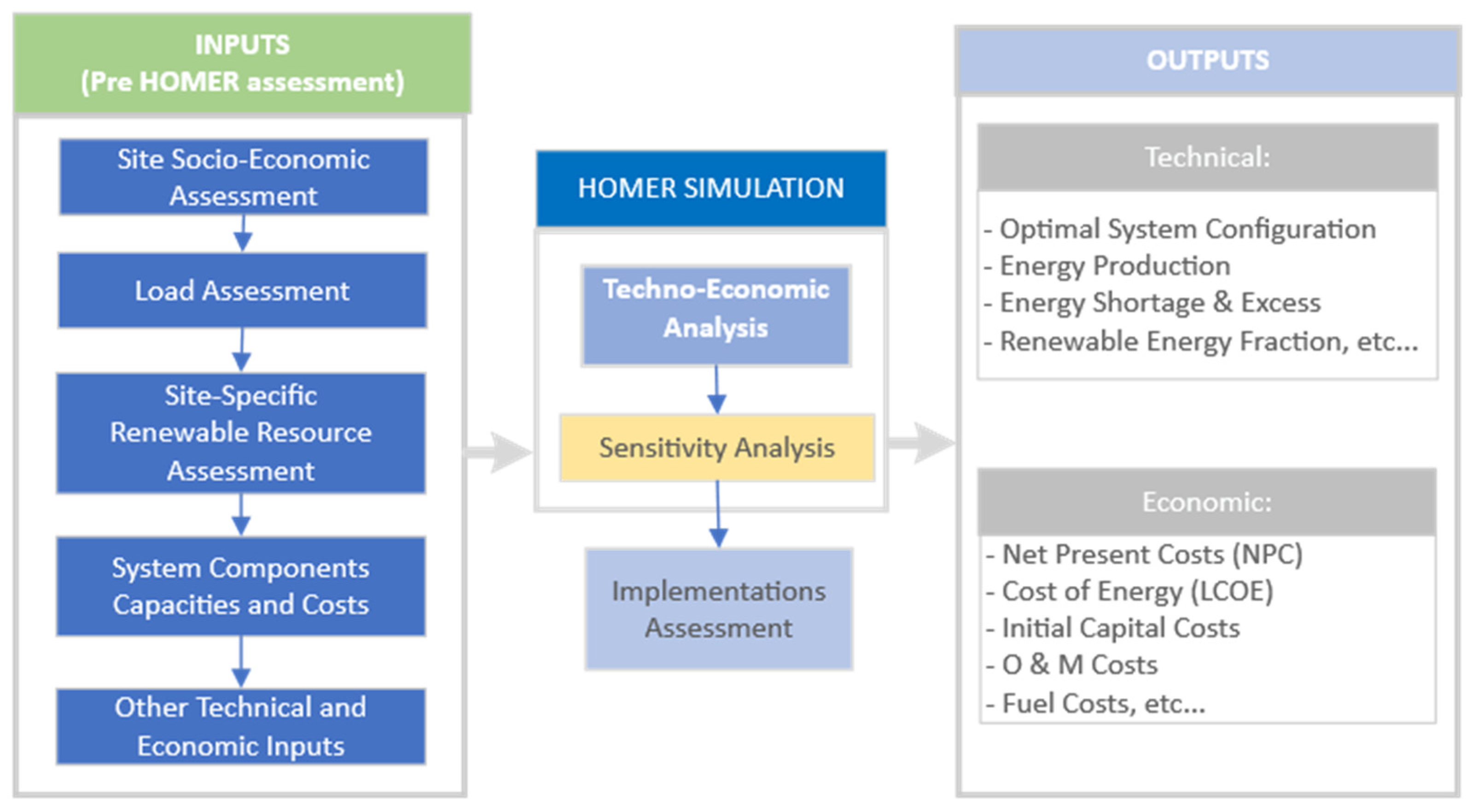
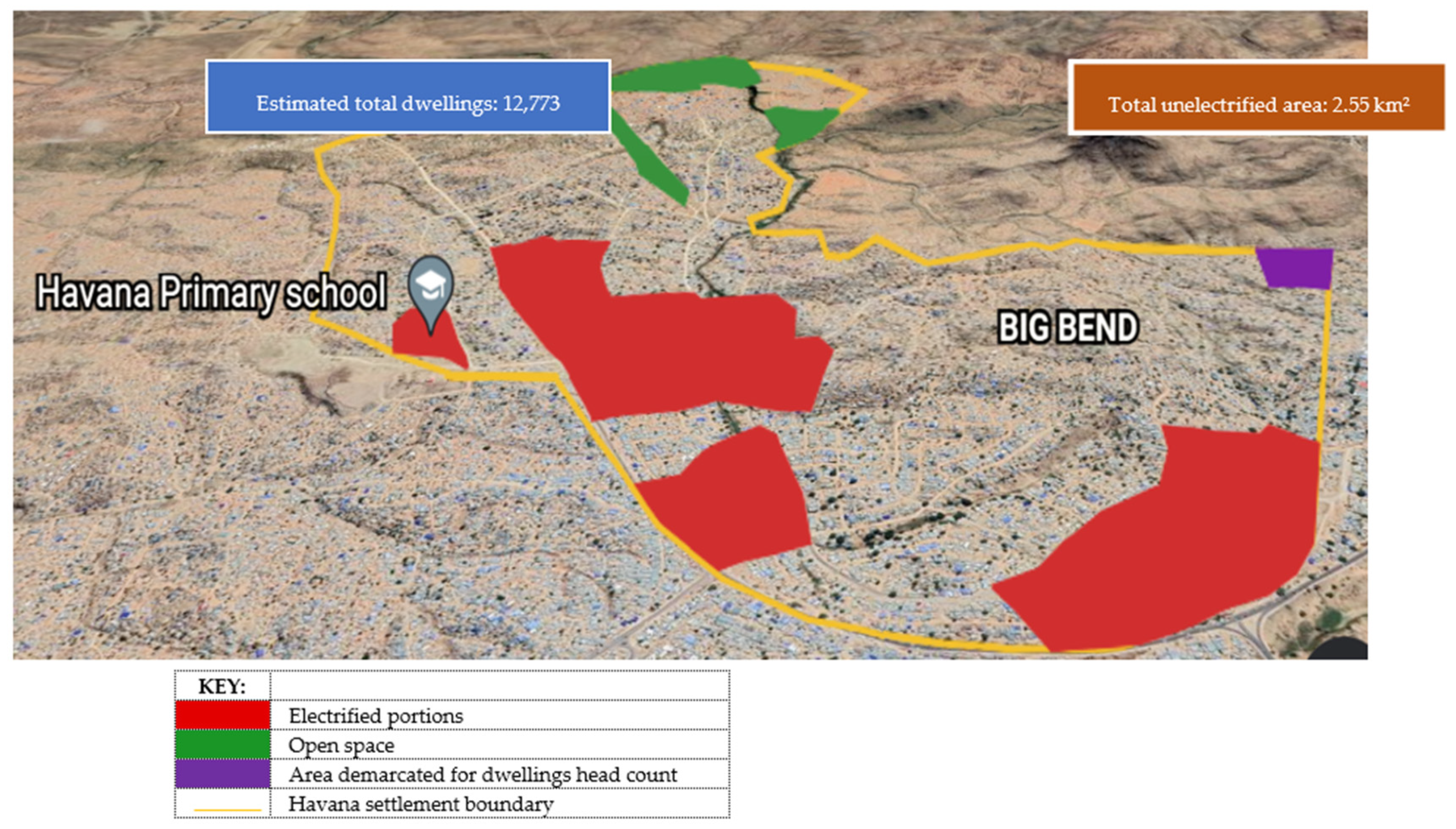
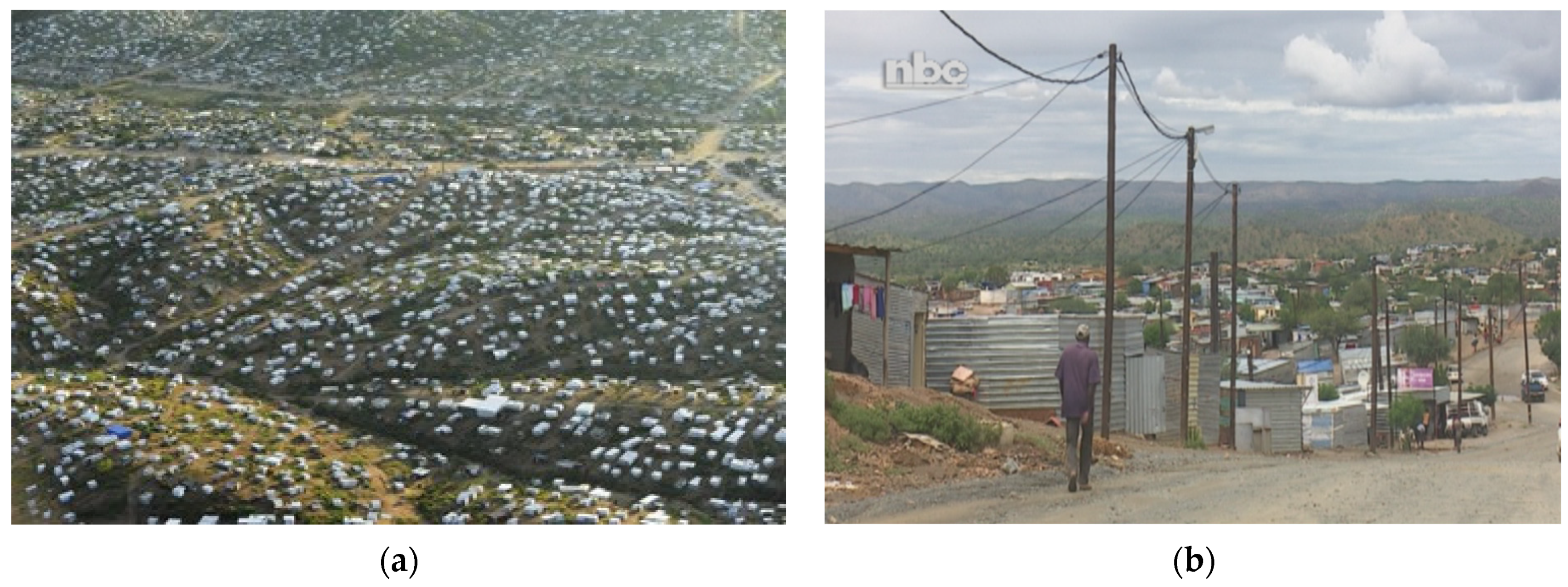


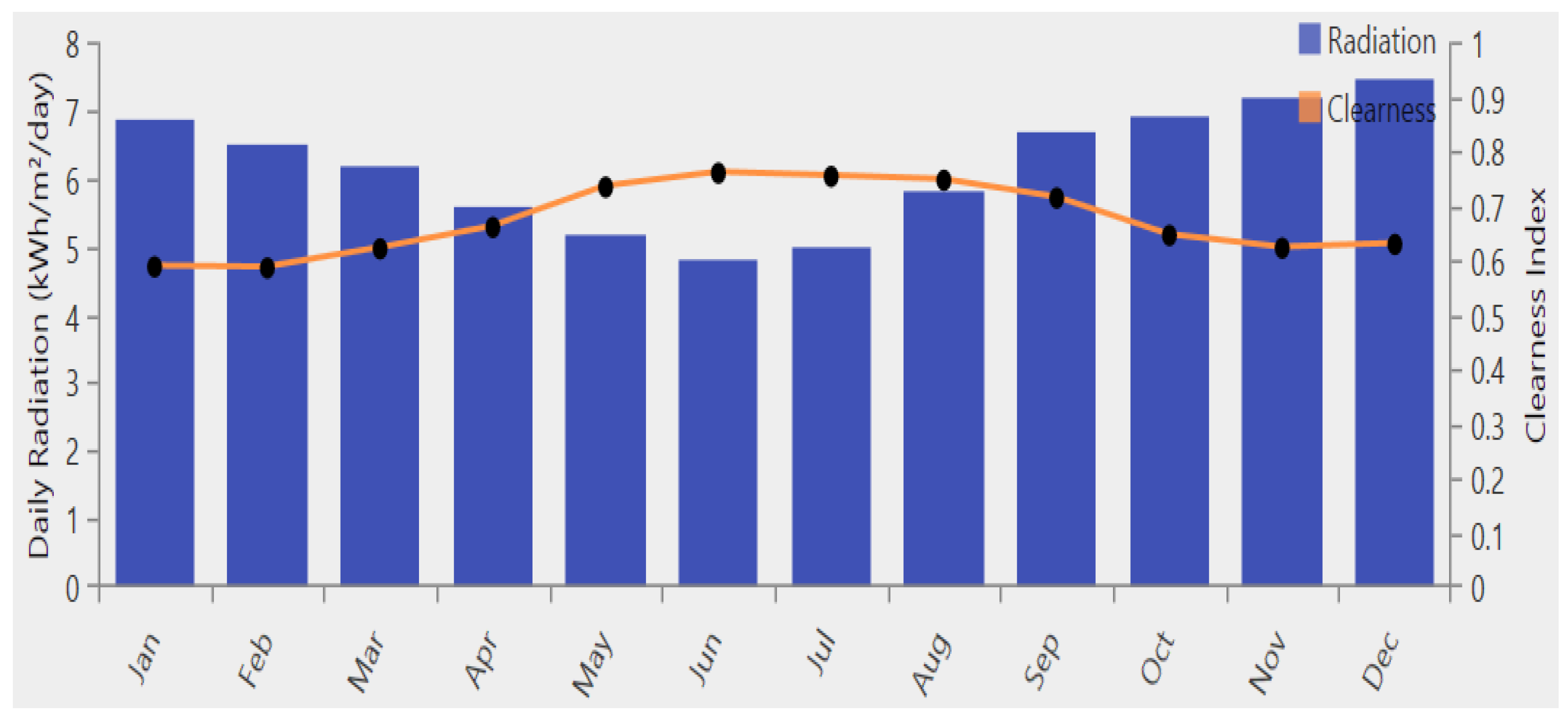
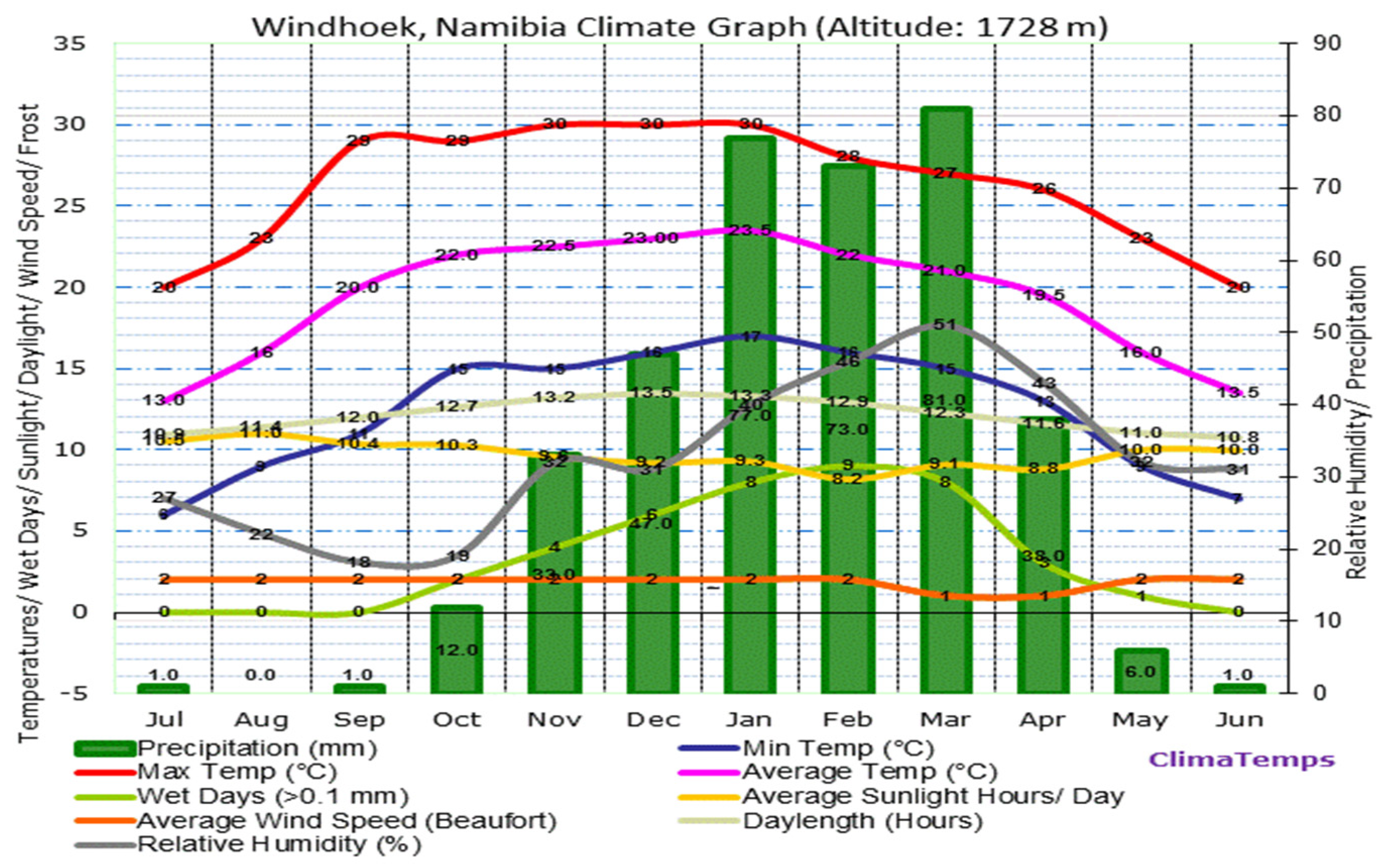
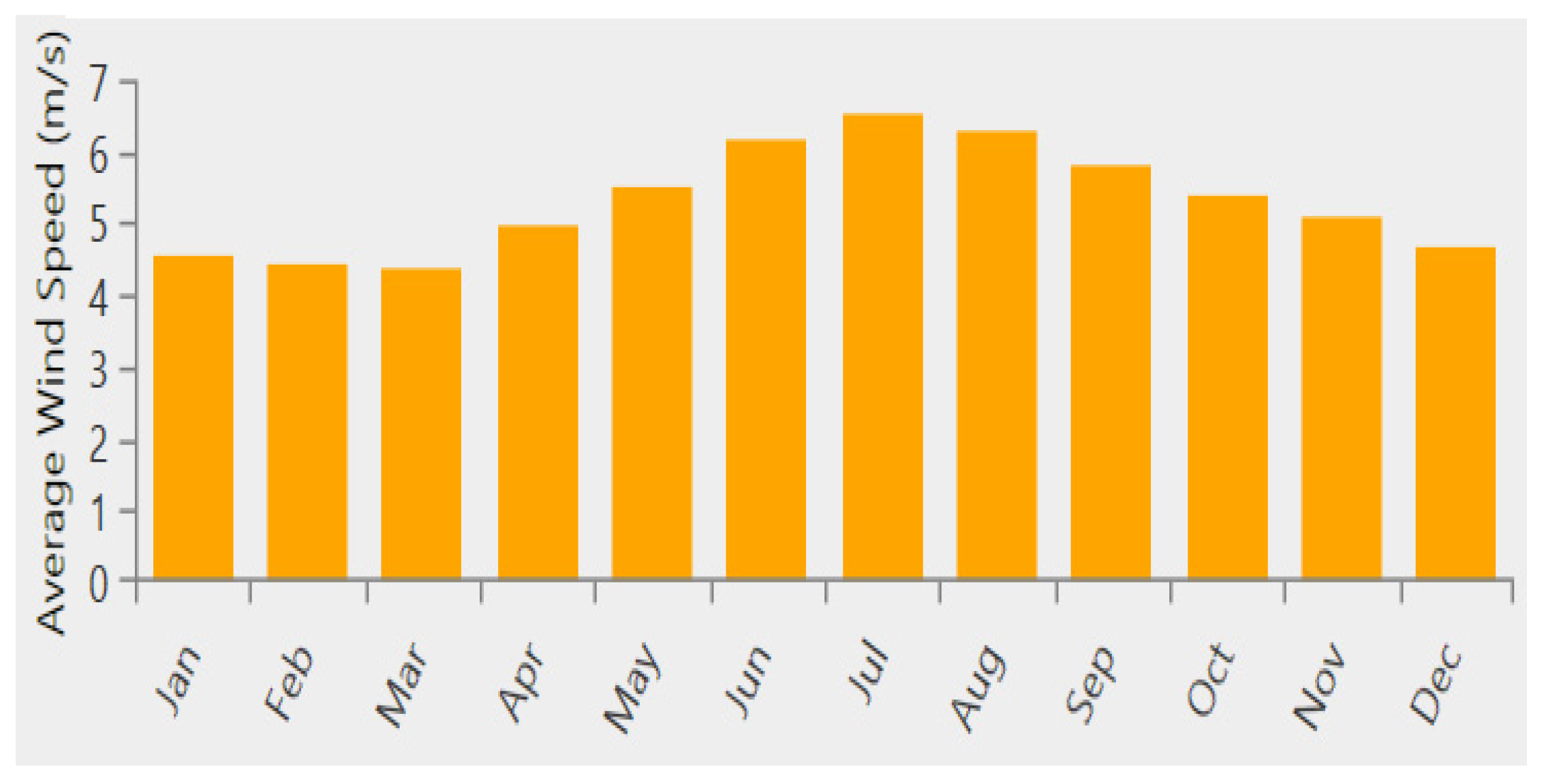

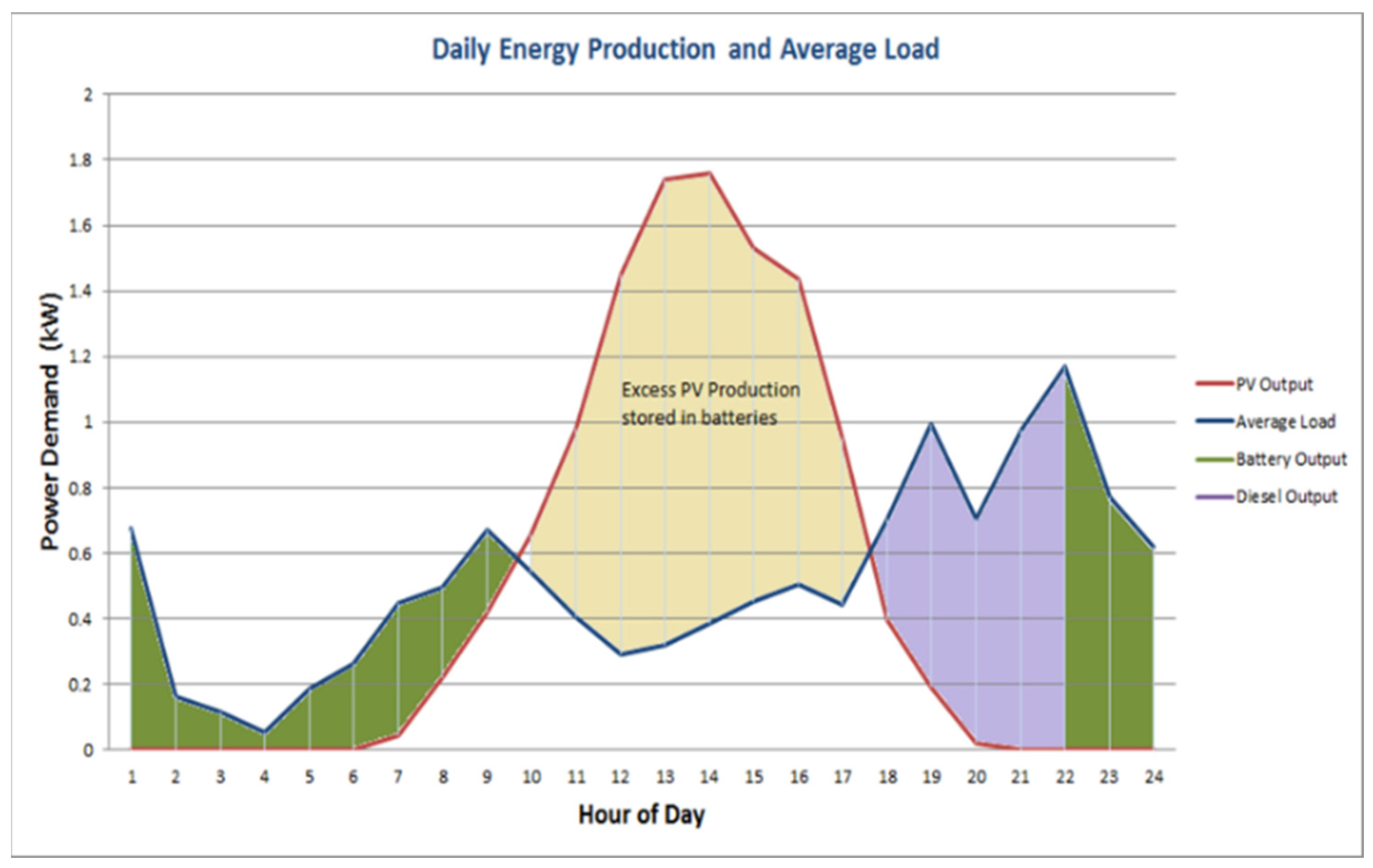

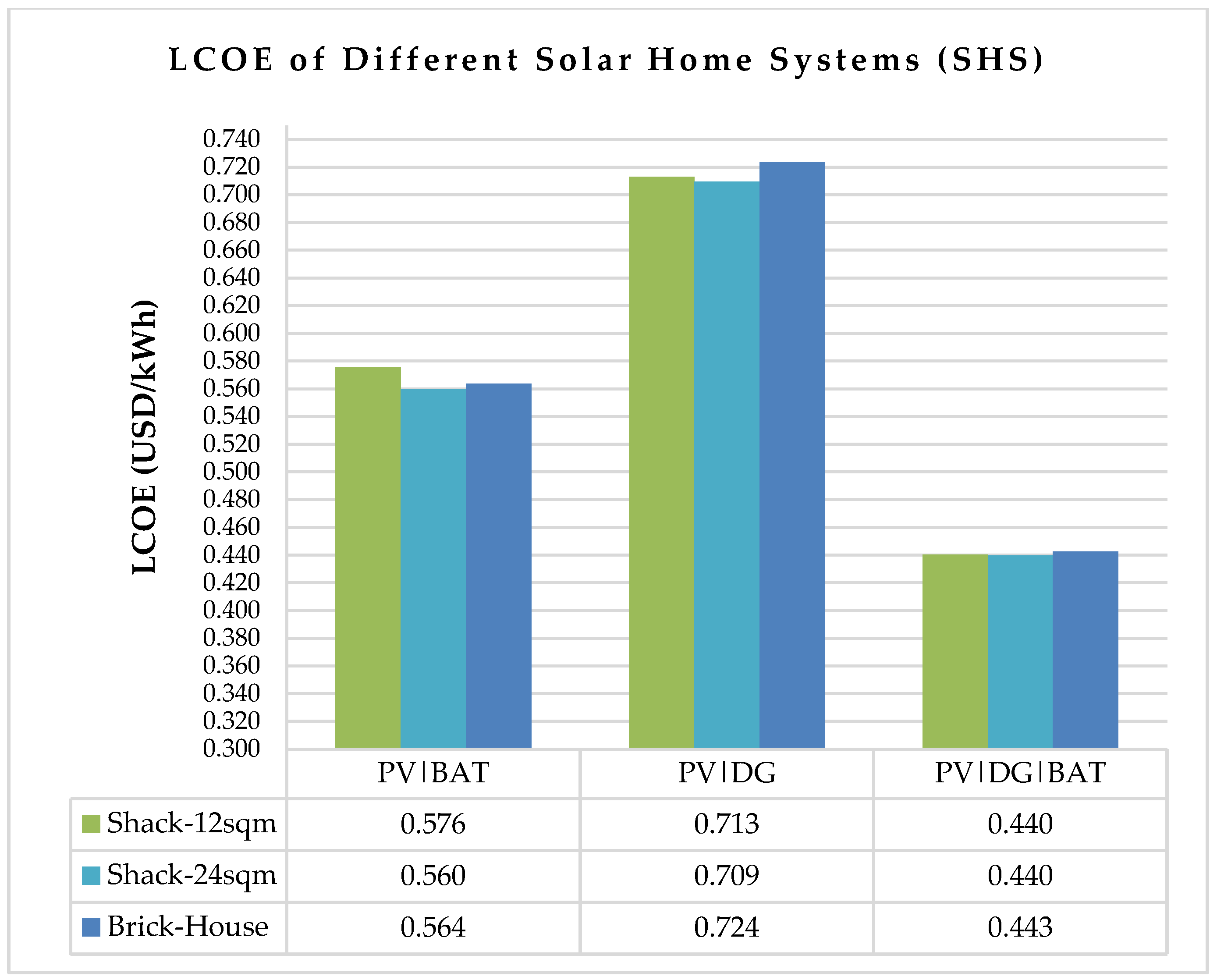





| Power Plant | Type | Built | Capacity (MW) | Operating Modus |
|---|---|---|---|---|
| Ruacana | Hydro | 1978 | 347 | Flexible/Baseload |
| Van Eck | Coal | 1973 | 90 | Stand-by |
| Anixas | Diesel | 2011 | 22.5 | Stand-by |
| IPPs 1 | Solar | vary | 174.5 | Flexible |
| IPPs 1—Ombepo | Wind | 2019 | 5 | Flexible |
| IPPs 1—N-BiG | Biomass | 2010 | 0.5 | Flexible |
| Total Capacity (MW) | 639.5 | |||
| Parameter | Value |
|---|---|
| Location name and city: | Havana settlement, Windhoek, Namibia |
| Type of location: | Informal settlement (peri-urban area) |
| Longitude: | 22°29′ S |
| Latitude: | 17°01′ E |
| Population: | ≈96,000 [10] |
| Estimated number of dwellings: | ≈12,773 |
| Main type of dwellings: | Shacks made of corrugated iron [10] |
| Main source of energy: | Electricity (for the electrified area), kerosene, and firewood (for un-electrified area) |
| Dominant population: | 20–40 years (male and female) [9] |
| Main source of income: | Small informal businesses, general labor, and construction labor [10] |
| Monthly income: | USD 30–2500 [10] |
| Component | Product Specification | Rating (kW) | Unit Cost ($/Wp) | Capital Cost (USD) 1 | Replacement Cost (USD) 1 | O&M Cost 2 (USD) | Lifetime (Years) |
|---|---|---|---|---|---|---|---|
| PV module | Generic flat plate | 1 | 0.6 | 600 | 540 | 10 | 25 |
| Wind turbine | Generic | 3 | 3.0 | 9000 | 9000 | 180 | 20 |
| Converter | Generic | 1 | 0.25 | 250 | 225 | 5 | 15 |
| Deep cycle battery | Generic lead Acid | 1 kWh | 0.49 | 490 | 430 | 10 | 5 |
| Diesel generator | Auto-size Genset | N/A | 500 | N/A | 500/kW | 0.03/h | 15,000 h |
| Parameter | Value |
|---|---|
| Project lifetime | 25 years |
| Annual discount rate 1 | 8% |
| Inflation rate 1 | 4.5% |
| Diesel fuel cost 2 | USD 1.08/L |
| Load | Configuration | Capacity 1 | DS 2 | EP 3 MWh/Year | REP 4 % | EE 5% | NPC 6 USD Thsd 13 | CAP 7 USD Thsd 13 | LCOE 8 US$/kWh | DPP 9 Years |
|---|---|---|---|---|---|---|---|---|---|---|
| Shack-24sqm | PV|BAT | 1.68 kW|5 kWh|0.437 kW | CC 10 | 3.25 12 | 100.0 | 63.6 | 9.27 | 3.57 | 0.560 | - |
| PV|DG | 1.63 kW|0.49 kW|0.168 kW | CC | 4.08 12 | 77.2 | 75.4 | 11.76 | 1.26 | 0.709 | 5.20 | |
| PV|DG|BAT | 0.98 kW|0.49 kW|2 kWh|0.27 kW | LF 11 | 2.26 12 | 84.0 | 52.2 | 7.29 | 1.88 | 0.440 | 2.85 | |
| Microgrid-Roof | PV|BAT | 2.41 MW|5.74 MWh|0.56 MW | CC | 4.68 | 100.0 | 67.4 | 13,587 | 5295 | 0.633 | - |
| PV|DG | 1.87 MW|0.59 MW|0.21 MW | CC | 4.79 | 75.7 | 72.8 | 12,110 | 1703 | 0.563 | 7.09 | |
| PV|DG|BAT | 1.06 kW|0.59 MW|1.25 MWh|0.32 MW | LF | 2.66 | 76.9 | 49.2 | 8297 | 1889 | 0.386 | 3.14 | |
| Microgrid-Ground | PV|BAT | 26.61 MW|63,424 kWh|6508 kW | CC | 51.63 | 100.0 | 67.7 | 150,825 | 58,532 | 0.644 | - |
| PV|DG | 19.55 MW|6.60 MW|2.24 MW | CC | 50.94 | 74.5 | 72.2 | 131,984 | 18,045 | 0.564 | 6.74 | |
| PV|DG|BAT | 11.52 MW|6.60 MW|12.18 MWh|3.53 MW | LF | 29.37 | 76.1 | 49.9 | 90,834 | 19,840 | 0.388 | 3.05 | |
| PV|WT|BAT | 17.77 MW|1.40 MW|61.64 MWh|6.06 MW | CC | 42.49 | 100.0 | 62.6 | 135,440 | 63,577 | 0.579 | 5.17 | |
| PV|WT|DG | 19.42 MW|—|6.60 MW|2.19 MW | CC | 50.71 | 74.3 | 72.0 | 131,933 | 17,940 | 0.563 | 6.69 | |
| PV|WT|DG|BAT | 8.87 MW|0.87 MW|6.60 MW|12.55 MWh|3.19 MW | LF | 27.69 | 80.0 | 47.4 | 88,222 | 25,851 | 0.377 | 3.65 |
Publisher’s Note: MDPI stays neutral with regard to jurisdictional claims in published maps and institutional affiliations. |
© 2022 by the authors. Licensee MDPI, Basel, Switzerland. This article is an open access article distributed under the terms and conditions of the Creative Commons Attribution (CC BY) license (https://creativecommons.org/licenses/by/4.0/).
Share and Cite
Amupolo, A.; Nambundunga, S.; Chowdhury, D.S.P.; Grün, G. Techno-Economic Feasibility of Off-Grid Renewable Energy Electrification Schemes: A Case Study of an Informal Settlement in Namibia. Energies 2022, 15, 4235. https://doi.org/10.3390/en15124235
Amupolo A, Nambundunga S, Chowdhury DSP, Grün G. Techno-Economic Feasibility of Off-Grid Renewable Energy Electrification Schemes: A Case Study of an Informal Settlement in Namibia. Energies. 2022; 15(12):4235. https://doi.org/10.3390/en15124235
Chicago/Turabian StyleAmupolo, Aili, Sofia Nambundunga, Daniel S. P. Chowdhury, and Gunnar Grün. 2022. "Techno-Economic Feasibility of Off-Grid Renewable Energy Electrification Schemes: A Case Study of an Informal Settlement in Namibia" Energies 15, no. 12: 4235. https://doi.org/10.3390/en15124235






